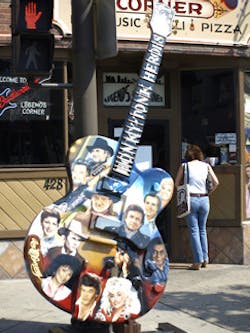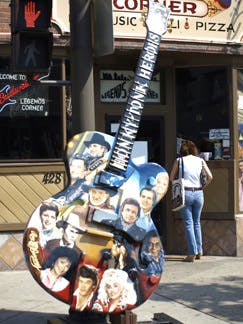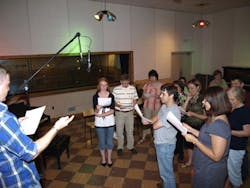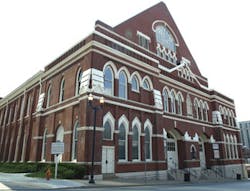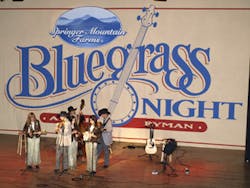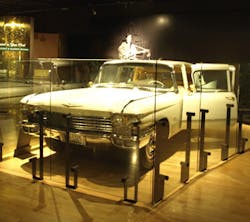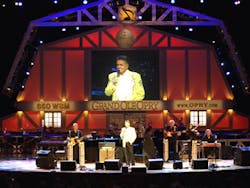The Sights and Sounds of Nashville
"Stand by," says the producer. I throw back my shoulders, take a deep breath and look at the giant microphone. Along with thirteen other folks, I'm in Nashville's RCA Studio B, the recording studio where Dolly got her start, where Elvis recorded 262 of his songs and where, in about one second, our raggedy-tag group is going to record our version of an Elvis hit song.
"We're rolling!" Ben, the sound engineer, disappears into the control room. The music starts. Danny, our personal producer, signals us to sing along.Holding the song sheets high and opening our mouths wide, we try.
Okay, so we don't sound like the King. But we're in Nashville, the Music City, and we're in the very room where Elvis once stood. It's a heady feeling, and we're all grinning ear-to-ear. We may not be stars, but we're definitely star-struck!
Music is everywhere in Nashville — from the airport where musicians strum a welcome to arriving passengers to street corners where public works boxes have been rigged to provide a musical background for pedestrians. And in a city where virtually everybody is either a part of the music industry or knows someone who is, gossipy tales about the greats, or near-greats, abound.
At Studio B we learn that Elvis liked to come into the studio somewhere around 11 p.m., munch a few hamburgers, sing some gospel to warm up, and then, as dawn broke, settle down to record his hits. "'Crying in the Chapel,'" Danny tells us, "was recorded around 5 a.m."
Another tidbit: When, early in her career, Dolly arrived to sing along with Porter Wagoner, she was so nervous she bumped her car into the building. I don't know why these gossipy notes please me, but they do. Maybe it's because they make me feel like an insider.
The Nashville music scene is changing. It's not just country anymore and, even when it is, the definition of country is expanding. Bluegrass has the banjo, but when Chet Atkins helped create the "Nashville Sound," he removed the banjo's twang and backed the singer with a full orchestra.
At the Wild Horse Saloon, where music blares from the stage as people line-dance on the largest dance floor in town, manager Ward Murphy estimates that country is probably only forty percent of Nashville's music. Today people can find almost any type of music they want in Nashville — from country to symphony, gospel to rock.
Nevertheless, my husband and I are here to immerse ourselves in country, and we begin at one of its most important historic venues, the Ryman Auditorium. Built in 1892 so that a charismatic preacher could spread the word of the Lord, the Ryman instead became know for spreading the sounds of country.
In 1925 Nashville radio station WSM began broadcasting a down-home music program known as the "WSM Barn Dance," a medley of rural music that attracted a huge following. The show aired right after a satellite broadcast of the New York Opera, which caused announcer George D. Hay to make a memorable quip. "Folks," he said, "for the last hour you've been listening to music taken largely from the grand opera. Well, y'all just sit on back 'cause from now on you're gonna hear the Grand Ole Opry!" The name stuck.
But people wanted to do more than hear the Grand Ole Opry. They wanted to see it too, and before long the Opry became a radio show that people paid to watch. By 1943 it had outgrown four venues, and only the Ryman, with its superior acoustics (surpassing those of the Carnegie and second only to those of the Mormon Tabernacle), offered the space and sound that the Opry needed.
The Opry — now the longest-running live radio show in the world — moved on in 1974, and is now located at the high-tech Grand Ole Opry House a few miles away. But the Ryman remains its spiritual home. In fact, when the Opry moved to its new location, a six-foot circle of hardwood was taken from the Ryman and placed center stage at the Opry House. The Ryman was renovated in 1994 and, since then a variety of performers — from Sinatra to Springsteen to [Brittany] Spears — have appeared on its hallowed stage.
But we eschew the contemporary to attend a bluegrass concert by Cherryholmes, a relatively new band that was named 2005 IBMA Entertainers of the Year. We sit in the old wooden pews and feel enveloped by history and blown away by music. The group gives a foot-tapping, knee-slapping, hand-clapping performance that embodies the energy and spirit of the old barn dance days.
Later we wander around the corner to the honky-tonk district, located on Broadway between Third and Fifth Avenues. During Opry's heyday at the Ryman, performers often whiled away the time at the honky-tonks — singing, strumming and drinking — until it came time for them to perform. Today the honky-tonks provide music nearly round the clock.
We still want to educate ourselves on the finer points of country music. The obvious place to do that is at the Country Music Hall of Fame, a 130,000-square foot state-of-the-art museum that tells the story of country music. We listen to snippets of songs by musical icons, see plaques of those inducted into the circular Hall of Fame, and gaze awestruck at Elvis's "solid gold" Cadillac, encrusted with forty coats of crushed diamonds and fish scales and crowned with headlights rimmed with 24-karat gold plate.
A few blocks away is Hatch Show Print, which gained nationwide fame when it printed posters advertising Grand Ole Opry performances. Actually the store predates the Opry by 44 years. It began operation in 1879, using hand-carved blocks and wood type to create posters that were slapped on buildings and barns across rural America. Today it's a national landmark listed on the National Registry of Historic Places. Their clientele, which now includes Bob Dylan and Bruce Springsteen, is as prestigious as their posters.
With a night to spare before attending the Grand Ole Opry, we go to the Bluebird Café, the most well-known "listening room" in town. The café books up-and-coming songwriters who test their songs on their colleagues and on a small group of avid music fans. It has helped launch the careers of Garth Brooks, Trisha Yearwood and Faith Hill and is the place where dreams often become reality.
Finally, the night we've been waiting for — the performance of the Grand Old Opry. For two and a-half hours we listen to a variety of musicians playing country, gospel, bluegrass and even a smattering of country-rock. It's a festive occasion both inside the auditorium and outside on the plaza.
We wander in and out, often hearing a performer sing inside the auditorium and then again on the stage in the plaza. The inside show goes out over WSM 650, a 50,000-watt AM radio station, that can be heard in 33 states and parts of Canada. It is also streamed live on the Grand Ole Opry website.
As we leave — through the gift shop, of course — we pick up a six-pack of GOO-GOOs, a made-in-Nashville concoction of chocolate, caramel, marshmallow and nuts. In reality, the confection was a local favorite for years before the opera began, but when folks started assuming that the title stood for Grand Ole Opry, well, the Standard Candy Company that makes it saw no reason to complain.
Roy Acuff, we're told, was a long-time Goo-goo fan. If it's good enough for Roy, it's good enough for us — the perfect sweet to top off a magical musical visit.
When you go:
Grand Ole Opry: 800-SEE-OPRY; www.opry.com.
Ryman Auditorium: 615-889-3060; www.ryman.com
Country Music Hall of Fame: 615.416-2001; www.countrymusichalloffame.com
Studio B: Affiliated with the Country Music Hall of Fame; see contact information below. Recordings only for pre-scheduled groups. Individuals who want to record their own song, can do so at the Ryman.
Bluebird Cafe: 615-383-1461; www.bluebirdcafe.com
Wild Horse Saloon: 615-902-8200p; wildhorsesaloon.com
Hatch Show Prints: 615-256-2805; www.hatchshowprint.com
While in Nashville:
Music permeates, but there are other must-sees.
The Parthenon is undoubtedly the most unexpected. Built in 1897 for the Tennessee Centennial, it is an exact replica of the one in Athens. In fact, since the original is missing the roof and is largely in ruins, the Nashville Parthenon is even closer in appearance to the one that Plato and Aristotle frequented. 615-862-8431;www.nashville.gov/parthenon
The Hermitage, home of Andrew Jackson, is a lovely example of nineteenth-century architecture and a tour of the house and grounds gives insight into the life of our seventh president. 615-889-2941; www.thehermitage.com
Belle Meade Plantation was once one of the largest private estates in Nashville. Today visitors can tour the mansion as well as an old slave cabin, the gardens, carriage house and stables. 615-356-0501; www.bellemeadeplantation.com
For down home country food so good that its brought raves from people as different as Martha Stewart and Willard Scott, go to the Loveless Café. 615-646-9700; www.lovelesscafe.com
For more: www.visitmusiccity.com
